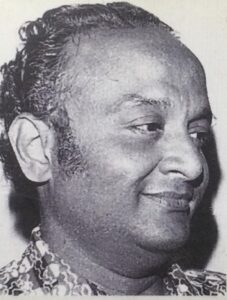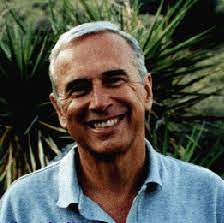by Sachi Sri Kantha, November 19, 2023
Madabhushi Rangadorai, aka Randor Guy: DOB – 1937 Nov 8 and DOD – 2023 Apr 23
Prof. Robert L. Hardgrave Jr: DOB – 1939 Feb 6 and DOD – 2023 May 21.
As one of the biographers of M.G. Ramachandran (MGR), an Indian movie star turned a successful politician, it is my onus to record the recent deaths of two MGR chroniclers, belonging to a generation earlier to me.

Randor Guy (circa 1990s)
Whereas Randor Guy (an anagram of his birth name Rangadorai) was an Indian, Prof. Hardgrave was an American. Both are recognized for contributing their share to the budding MGR scholarship. Their writings were complimentary in format. Whereas Randor Guy dealt with the filmography of MGR from 1930s to 1970s, Prof. Hardgrave contributed academically on MGR’s initiation and prominence of DMK politics from 1950s to early 1970s.
After I began writing my MGR biography in late 2012, I had email correspondence with both in 2013 and 2014. Prof. Hardgrave was more forthcoming in providing some details about his interactions with MGR and his DMK peers in politics and forwarded me reprints of his publications. Randor Guy, to be frank, was rather reticent in answering a couple of queries I had posed to him. This indicated to me the difference between an academic and a quasi-academic. Randor Guy was angling to have a ‘lecture tour’ arranged by me in Japan. As I consider myself a tramp scientist in Japan without any tenured faculty job, I could not provide him with the necessary contacts to make his wish come true.

Prof. Robert L. Hardgrave Jr.
In their writings, I could also see a difference in style and format between Randor Guy and Prof. Hardgrave. Whereas the latter was more academic, Randor Guy was more gossipy, sharing tidbits heard from second hand sources. One can attribute this to their training. Prof. Hardgrave was trained in sociology research. Randor Guy’s primary calling was law. In 1950s, he had worked as a legal apprentice under a recognized Chennai-Mylapore lawyer V.C. Gopalaratnam (also interested in stage plays), who had clients in the movie industry, including MGR and his elder brother M.G. Chakrapani. Because of this connection, out of quite many back room stories about actors, producers and their financial dealings Randor Guy was able to pick the crumbs and recycle them as journalistic pieces. One can also sniff in these pieces, randomly sprinkled, self-gloating sentiments about his personal contacts to Chennai’s cinema celebrities. I’ll provide a couple of samples from Randor’s notes on K. Thavamani Devi and MGR below. His trademark is using the exclamatory mark in every other sentence.
In describing the Vana Mohini (1941) Tamil movie, Randor wrote about K. Thavamani Devi (the only Jaffna-born actress who received star-billing in early 1940s in Chennai) as follows:
“The film bestowed stardom on the heroine, the seductive K. Thavamani Devi of Sri Lanka. A rehash of a Hollywood ‘jungle’ movie featuring Dorothy Lamour, Vana Mohini saw Thavamani wear the same costume, a revealing Hawaiian-style sarong. This was the first time such an outfit was worn in a Tamil movie and the sarong contributed a lot to its success!… Vana Mohini was a booming box office success and Thavamani’s fame soared higher. Now she began to insist on designing her costumes and doing the make-up herself, making it a condition of her contract! Something unheard of at that time in Indian Cinema!
Thavamani Devi hailed from Jaffna and her father was a wealthy and successful barrister in Ceylon. Blessed with stunning looks and melodious voice, she was not surprisingly attracted to the fine arts like music and dance. Encouraged by parents, she moved to Madras, the cultural capital of India. Here in the provincial capital of the Madras Presidency (as it then was) during the British rule, she learnt Bharatanatyam. She also took lessons in Carnatic Music…In 1957, the Salem-based movie mogul T.R. Sundaram re-made it in Sinhala as Wana Mohini, directed jointly by him and the well-known multilingual filmmaker A.B. Raj.” [The Hindu, May 28, 2011]
One should not forget that when Vana Mohini was released in 1941, Randor was only 4 years old! His descriptions about Thavamani Devi ‘designing her costumes and doing the make-up herself’ were second or third hand information from studio hands, who had worked in that particular movie.
In describing MGR’s first hero role for the Rajakumari (1947) movie, check how Randor writes about MGR and the production details of the Rajakumari movie. When this movie was released, he was only 10 years old!
“Around 1946, Jupiter Somu asked A.S.A. Sami to come up with a screenplay that he could direct himself…Somu had made it clear to Sami that as he was a novice in direction, he would have to work only with artistes on Jupiter’s rolls and not with big names with high price tags…Who would play the hero? One man on the studio rolls appeared to be a possible choice. He was handsome and athletic. His classical dance number in Sri Murguan had impressed many, especially Sami. Afte rmuch hesitation, he was asked to play the lead. The actor was M.G. Ramachandran – it proved to be a great moment not only in his life but also in the Indian film history.
The producer had planned Rajakumari as an 11,000 feet picture, and after shooting 7,000 feet, nobody was impressed. To Sami’s shock, S.K.Mohideen suggested seriously to his partner Somu, that the picture be abandoned!…Jupiter Somu, an enterprising man, asked Sami to go ahead with the film. Sami had a couple of interesting and amusing experiences about the making of the film. One was with Thavamani Devi who had a dress (designed by her!) with a plunging neckline; it caused ripples on the set! The Sri Lankan charmer,, Thavamani Devi was cast as a vamp…” [The Hindu, Sept 5, 2008]
The S.K. Mohideen mentioned was the partner in Jupiter Pictures with M. Somasundaram (Somu) chettiar. There’s hardly any doubt, that Randor would have received the above tid-bits from Rajakumari’s director A.S.A. Sami decades after the fact. Randor’s such notes were collected in his book, ‘Starlight, Starbright – the Early Tamil Cinema’ (1997, 309 pp). It contains chapters on 31 Tamil cinema pioneers including actors, producers, directors and script writers.
Randor Guy’s gossipy style of writing also permitted him to chronicle the murder mystery of notorious cinema gossip journalist C.N. Lakshmikantham on November 9, 1944, in which the then famous Tamil movie personalities (actors M.K. Thyagaraja bhagavathar, N.S. Krishnan and producer S.M. SreeRamulu Naidu) got entangled. Randor ended his chronicle in such a fashion “The real killers were never caught and the Truth lies buried somewhere, to this day. Truth will out they say, and one like this writer wonders when! Perhaps, someday…one day…!”
Following the traditions of University of Chicago anthropologists, Robert Redfield (1897-1958) and Poland-born Milton Singer (1912-1994), Robert Hardgrave became one of the pioneer American scholars to study the politics of Tamil Nadu in early 1960s. He had relatively easy access to the sources he wished to interview. Being interviewed by a white-skinned American in 1960s had a snob appeal for the Tamil Nadu politicians then. But Hardgrave was handicapped by his lack of fluency in spoken Tamil. Thus, he needed interpreting assistants. While reviewing M.S.S. Pandian’s booklet ‘M.G. Ramachandran in Film and Politics (1992) for Pacific Affairs journal in 1993, in my view, Hardgrave wrote a warped opinion: ‘It can fairly be said that he (MGR) was a bad actor and a worse politician – at least for the state and the larger number of people.’ In one of his emails to me in 2013, Hardgrave was frank in admitting his Tamil language deficit (especially in interviewing MGR in Dec 1969).
Here are two facts: (1) MGR acted only in Tamil movies (talkies). (2) Hardgrave could not grasp spoken Tamil properly. As such, his evaluation on MGR’s acting ability is nothing but warped. As for Hardgrave’s view that MGR was ‘a worse politician’, one may ask ‘compared to whom?’ – like American president Jimmy Carter and a Nobel peace prize laureate, who turned a blind eye to Khmer Rouge atrocities in Cambodia during his tenure to be friendly with China’s dictators, or Indian politicians like Gandhis (mother and sons) or prime ministers Narasimha Rao and Manmohan Singh (who acted as prime minister-substitutes of Sonia Gandhi)?
Nitpicking aside, Prof Hardgrave’s peer-reviewed studies on the Nadar caste of Tamil Nadu and the emergence of DMK as a political force in 1960s were published in academic journals and their quality was rather good. But, Randor Guy’s contributions fall into the category of ‘gray literature’ (published in newspapers, newsletters, websites and blogs such as http://randorguy.galatta.com) and the quality was highly variable. Nevertheless, as the great Newton noted in a letter dated Feb 5, 1676 to Robert Hooke, ‘If I have seen a little further it is by standing on the shoulders of Giants’, I do not hesitate to acknowledge my intellectual debt to Prof. Hardgrave and Randor Guy. Both were giants to a degree. For the interested folks, I provide the email correspondence I had with Prof. Hardgrave in 2013, in a pdf file separately.
Email correspondence 2013 btw Prof. Robert Hardgrave Jr and Sachi Sri Kantha
Publications of Prof. Robert L. Hardgrave Jr.
[signed book reviews are excluded in this listing. The list below is incomplete.]
Hardgrave RL. The DMK and the politics of Tamil nationalism. Pacific Affairs, winter 1964-65; 37(4): 396-411.
Hardgrave RL. The riots in Tamilnad: Problems and prospects of India’s language crisis. Asian Survey, Aug 1965; 5(8): 399-407.
Hardgrave RL. The Dravidian Movement, Popular Prakashan, Bombay, 1965.
Hardgrave RL. Varieties of political behavior among Nadars of Tamilnad. Asian Survey, Nov 1966; 6(11): 614—621.
Hardgrave RL. Caste: Fission and Fusion. Economic and Political Weekly, July 1968; 3(26/28): 1065+1067+1069+1070.
Hardgrave RL. The Nadars of Tamilnad, University of California Press, Berkeley, 1969, 314 pp.
Hardgrave RL. Political culture and projective techniques. Comparative Political Studies, 1969; 2(2): 249-255.
Hardgrave RL. The film and the rise of DMK (an untold story of organized change). Monthly Commentary (Indian Inst. of Public Opinion), Apr-May 1970; 11: 11-12.
Hardgrave RL. Congress in India – Crisis and split. Asian Survey, 1970; 10(3): 256-262.
Hardgrave RL. Marxist dilemma in Kerala – administration and or struggle. Asian Survey, 1970; 10(11): 993-1003.
Hardgrave RL. Hardgrave replies to the reviewer of his ‘The Nadars of Tamilnad’. American Journal of Sociology, Mar 1971; 76(5): 927-928.
Hardgrave RL. The celluloid god: MGR and the Tamil film. South Asian Review, July 1971; 4(4): 307-314.
Hardgrave RL. Kerala Communist – contradictions of power. Studies in Communism Revisionism and Revolution, 1973; (19): 119-180.
Hardgrave RL. Film and mass politics in developing areas – Introduction. American Behavioral Scientist, 1974; 17(3): 325-327.
Hardgrave RL, Neidhart AC. Films and political consciousness in Tamil Nadu. Economic and Political Weekly, Jan 11, 1975; 10: 27-35.
Hardgrave RL. The Mappilla rebellion, 1921: Peasant revolt in Malabar. Modern Asian Studies, 1977; 11(1): 57-99.
Hardgrave RL. Politics and the film in Tamilnadu: the stars and the DMK. Asian Survey, Mar 1978; 13: 288-205.
.Hardgrave RL. India: from crisis to crisis. Current History, Apr 1979; 76: 159-163 & 180-181.
Hardgrave RL. India enters the 1980s. Current History, 1982; 81(475): 197-
Hardgrave RL. The Northeast, the Punjab and the regionalization of Indian politics. Asian Survey, Nov 1983; 23(11): 1171-1181.
Hardgrave RL. India in 1983: New challenges, lost opportunities. Asian Survey, Feb 1984; 24(2): 209-218.
Hardgrave RL. India in 1984 – Confrontation, assassination and succession. Asian Survey, Feb 1985; 25(2): 131-144.
Hardgrave RL. India on the eve of elections – Congress and the Opposition. Pacific Affairs, 1984; 57(3): 404-428.
Hardgrave RL, Slawek SM. Instruments and music culture in 18th century India – The Solvyns portraits. Asian Music, 1988; 20(1): 1-92.
Hardgrave RL. After the dynasty – Politics in India. Current History, Mar 1992; 91(563): 106-112.